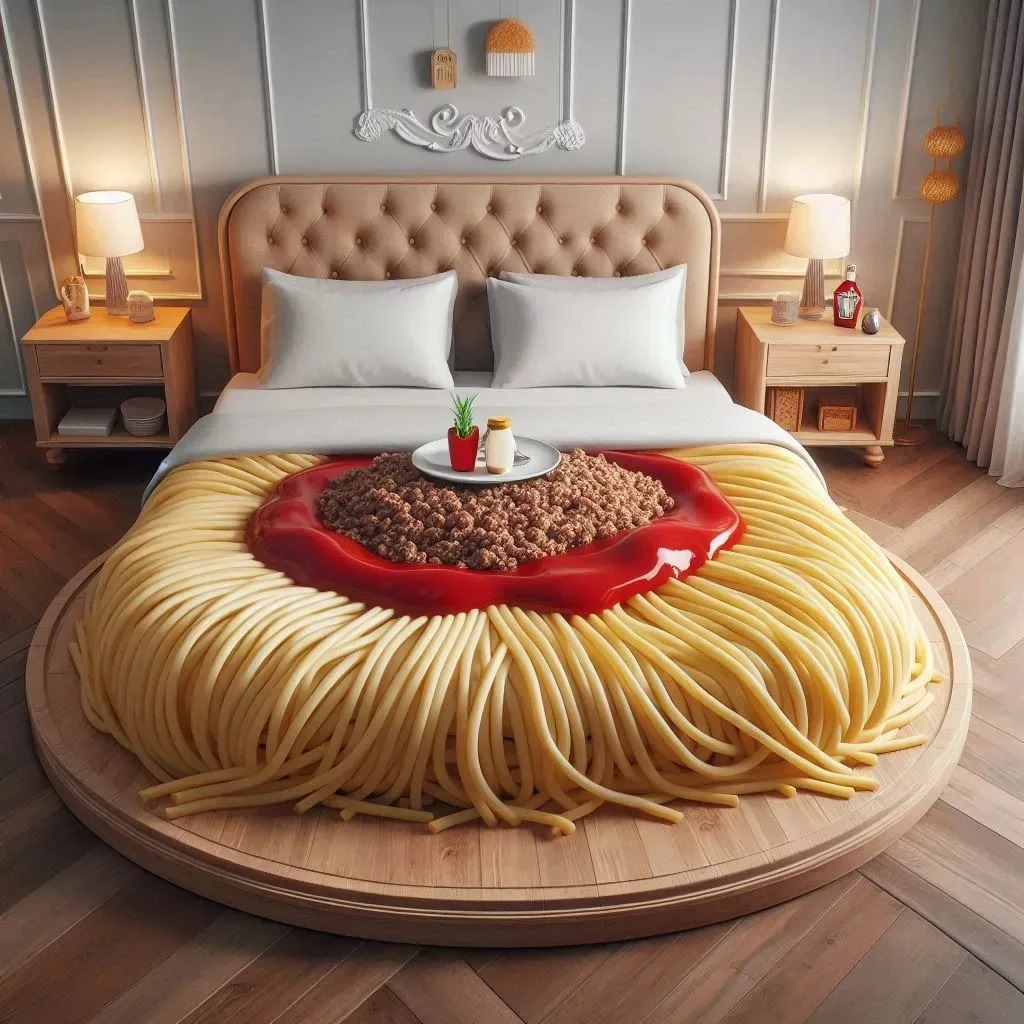
In the ever-evolving world of interior design, where creativity knows no bounds, a new trend has emerged that’s turning heads and raising eyebrows: spaghetti beds. Yes, you read that right – beds inspired by everyone’s favorite Italian pasta are making their way into bedrooms around the globe. This article delves into the fascinating world of spaghetti beds, exploring their origin, design, benefits, and why they might just be the next big thing in bedroom décor.
Contents
What Are Spaghetti Beds?

Spaghetti beds, despite their name, are not edible furniture made from actual pasta. Instead, they are cleverly designed beds that mimic the appearance of a tangled pile of spaghetti. These unique pieces of furniture typically feature a frame composed of numerous intertwined, noodle-like strands, creating a nest-like structure that cradles the mattress.
The concept behind spaghetti beds marries the comfort of a traditional bed with the whimsical aesthetics of pasta art. It’s a bold statement piece that transforms the bedroom into a playful, conversation-starting space.
The Origin of Spaghetti Beds

The exact origin of spaghetti beds is somewhat unclear, but they are believed to have emerged from the intersection of modern art, furniture design, and culinary inspiration. Some attribute the concept to Italian designers who sought to bring a touch of their country’s famous cuisine into home décor. Others see it as an extension of the broader trend of food-inspired furniture that has gained popularity in recent years.
Regardless of their precise origin, spaghetti beds have quickly captured the imagination of design enthusiasts and homeowners looking for something truly unique.
Design and Construction

Spaghetti beds come in various designs, but they all share the common theme of noodle-like elements. Some popular variations include:
- The Tangle: This design features a chaotic jumble of “noodles” that form the bed frame, reminiscent of a plate of freshly served spaghetti.
- The Weave: A more structured approach, where the noodle elements are woven together in a pattern, creating a harmonious blend of order and pasta-inspired chaos.
- The Spiral: Inspired by the way spaghetti wraps around a fork, this design incorporates spiral elements into the bed frame.
The materials used in constructing spaghetti beds vary, but common options include:
- Bent wood
- Molded plastic
- Metal tubing
- Fabric-covered foam
Each material brings its own unique aesthetic and practical considerations to the design.
Related post: Hamburgur bed
Comfort and Functionality

While the appearance of spaghetti beds might raise questions about comfort, manufacturers and designers have put considerable effort into ensuring these beds are not just visually striking but also comfortable and functional.
The noodle-like structure often provides excellent support for the mattress, distributing weight evenly and potentially offering better airflow than traditional solid bed frames. Some designs even incorporate adjustable elements, allowing users to modify the bed’s shape for optimal comfort.
Benefits of Spaghetti Beds

- Unique Aesthetic: Spaghetti beds are undoubtedly conversation starters, adding a touch of whimsy and personality to any bedroom.
- Customization: Many spaghetti bed designs offer customization options, allowing buyers to choose colors, materials, and even the “noodle” arrangement.
- Potential Space-Saving: Some spaghetti bed designs incorporate storage solutions within the noodle structure, making them ideal for smaller bedrooms.
- Versatility: While primarily designed for bedrooms, some spaghetti bed concepts have been adapted for use in living rooms as quirky sofas or daybeds.
- Mood Enhancement: The playful nature of spaghetti beds can contribute to a more relaxed and joyful atmosphere in the bedroom.
Challenges and Considerations

Despite their charm, spaghetti beds do come with some potential drawbacks:
- Cleaning: The intricate noodle structure can be challenging to clean, potentially trapping dust and requiring more maintenance than traditional beds.
- Cost: Due to their unique design and often custom nature, spaghetti beds can be more expensive than conventional bed frames.
- Durability: Depending on the materials used, some spaghetti bed designs may be less durable than traditional solid frames.
- Limited Availability: As a niche product, finding a wide selection of spaghetti beds might be challenging in some areas.
Who Are Spaghetti Beds For?
Spaghetti beds appeal to a diverse range of individuals, including:
- Design enthusiasts looking for unique, statement furniture pieces
- Food lovers who want to bring their culinary passions into their home décor
- Homeowners seeking to create a playful, whimsical bedroom atmosphere
- Interior designers working on eclectic or themed spaces
- Boutique hotels aiming to offer guests a one-of-a-kind sleeping experience
The Future of Spaghetti Beds
As the popularity of spaghetti beds grows, we can expect to see further innovations in their design and functionality. Some potential future developments might include:
- Smart spaghetti beds with integrated technology for sleep tracking and ambient lighting
- Eco-friendly versions made from sustainable or recycled materials
- Modular designs that allow users to easily modify the bed’s shape and size
Styling Tips for Spaghetti Beds
If you’re considering adding a spaghetti bed to your bedroom, here are some styling tips to make the most of this unique piece:
- Keep it Simple: Let the bed be the star of the show by keeping other furniture and décor elements relatively simple.
- Play with Textures: Complement the noodle texture of the bed with contrasting textures in bedding and surrounding furnishings.
- Color Coordination: Choose bedding colors that either complement or playfully contrast with the bed frame’s color.
- Lighting: Use creative lighting solutions to highlight the bed’s unique structure and create interesting shadows.
- Themed Accessories: Consider incorporating subtle pasta or Italian-themed accessories to tie the room together.
Conclusion
Spaghetti beds represent a bold and imaginative leap in bedroom furniture design. They challenge our perceptions of what a bed should look like and bring a sense of fun and creativity into the most personal space in our homes. While they may not be everyone’s cup of tea (or plate of pasta), spaghetti beds offer a unique option for those looking to make a statement with their bedroom décor.
As with any trend in interior design, the longevity of spaghetti beds remains to be seen. However, their current popularity speaks to a broader desire for personalization and whimsy in our living spaces. Whether you see them as a passing fad or the future of bedroom furniture, there’s no denying the impact spaghetti beds have made on the world of interior design.
So, the next time you’re considering a bedroom makeover, why not think outside the box – or in this case, outside the pasta bowl? A spaghetti bed might just be the perfect ingredient to spice up your sleeping space and add a dash of Italian-inspired charm to your dreams.







